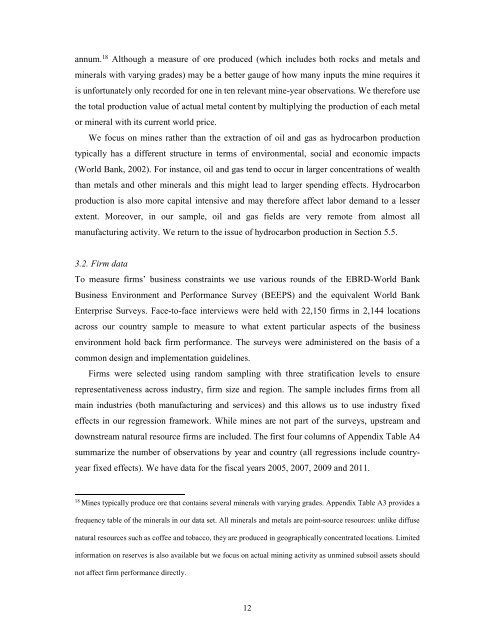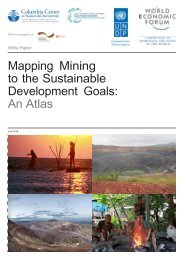Mining matters Natural resource extraction and local business constraints
2fCPiMQ
2fCPiMQ
You also want an ePaper? Increase the reach of your titles
YUMPU automatically turns print PDFs into web optimized ePapers that Google loves.
annum. 18 Although a measure of ore produced (which includes both rocks <strong>and</strong> metals <strong>and</strong><br />
minerals with varying grades) may be a better gauge of how many inputs the mine requires it<br />
is unfortunately only recorded for one in ten relevant mine-year observations. We therefore use<br />
the total production value of actual metal content by multiplying the production of each metal<br />
or mineral with its current world price.<br />
We focus on mines rather than the <strong>extraction</strong> of oil <strong>and</strong> gas as hydrocarbon production<br />
typically has a different structure in terms of environmental, social <strong>and</strong> economic impacts<br />
(World Bank, 2002). For instance, oil <strong>and</strong> gas tend to occur in larger concentrations of wealth<br />
than metals <strong>and</strong> other minerals <strong>and</strong> this might lead to larger spending effects. Hydrocarbon<br />
production is also more capital intensive <strong>and</strong> may therefore affect labor dem<strong>and</strong> to a lesser<br />
extent. Moreover, in our sample, oil <strong>and</strong> gas fields are very remote from almost all<br />
manufacturing activity. We return to the issue of hydrocarbon production in Section 5.5.<br />
3.2. Firm data<br />
To measure firms’ <strong>business</strong> <strong>constraints</strong> we use various rounds of the EBRD-World Bank<br />
Business Environment <strong>and</strong> Performance Survey (BEEPS) <strong>and</strong> the equivalent World Bank<br />
Enterprise Surveys. Face-to-face interviews were held with 22,150 firms in 2,144 locations<br />
across our country sample to measure to what extent particular aspects of the <strong>business</strong><br />
environment hold back firm performance. The surveys were administered on the basis of a<br />
common design <strong>and</strong> implementation guidelines.<br />
Firms were selected using r<strong>and</strong>om sampling with three stratification levels to ensure<br />
representativeness across industry, firm size <strong>and</strong> region. The sample includes firms from all<br />
main industries (both manufacturing <strong>and</strong> services) <strong>and</strong> this allows us to use industry fixed<br />
effects in our regression framework. While mines are not part of the surveys, upstream <strong>and</strong><br />
downstream natural <strong>resource</strong> firms are included. The first four columns of Appendix Table A4<br />
summarize the number of observations by year <strong>and</strong> country (all regressions include countryyear<br />
fixed effects). We have data for the fiscal years 2005, 2007, 2009 <strong>and</strong> 2011.<br />
18<br />
Mines typically produce ore that contains several minerals with varying grades. Appendix Table A3 provides a<br />
frequency table of the minerals in our data set. All minerals <strong>and</strong> metals are point-source <strong>resource</strong>s: unlike diffuse<br />
natural <strong>resource</strong>s such as coffee <strong>and</strong> tobacco, they are produced in geographically concentrated locations. Limited<br />
information on reserves is also available but we focus on actual mining activity as unmined subsoil assets should<br />
not affect firm performance directly.<br />
12






